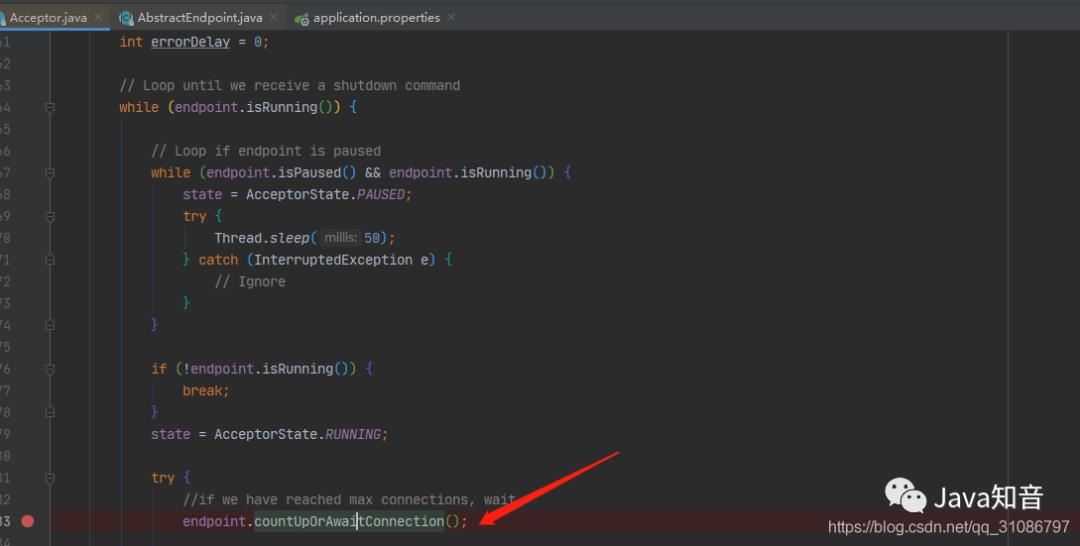SpringBoot 内置 Tomcat 线程数优化配置,你学会了吗?
Posted Java知音_
tags:
篇首语:本文由小常识网(cha138.com)小编为大家整理,主要介绍了SpringBoot 内置 Tomcat 线程数优化配置,你学会了吗?相关的知识,希望对你有一定的参考价值。
点击关注公众号,实用技术文章及时了解
前言
本文解析springboot内置tomcat调优并发线程数的一些参数,并结合源码进行分析
参数
线程池核心线程数
server.tomcat.min-spare-threads:该参数为tomcat处理业务的核心线程数大小,默认值为10
线程池最大线程数
server.tomcat.max-threads:该参数为tomcat处理业务的最大线程数大小,默认值为200,当对并发量有一点值时可以调大该参数
请求最大连接数
server.tomcat.max-connections:该参数为请求的最大连接数,默认值为10000,注意这个参数并不是设置在线程池上的,而是在tomcat的Acceptor类(专门处理连接的线程类)来控制的,结合源码我们可以看到

protected void countUpOrAwaitConnection() throws InterruptedException
if (maxConnections==-1) return;
LimitLatch latch = connectionLimitLatch;
if (latch!=null) latch.countUpOrAwait();
可以看到当最大连接数满了之后会进行等待
accept-count
server.tomcat.accept-count:这个参数实际上和tomcat没有太大关系,默认值为100
我们先看下文档的定义
/**
* Allows the server developer to specify the acceptCount (backlog) that
* should be used for server sockets. By default, this value
* is 100.
*/
private int acceptCount = 100;这个参数是服务端创建ServerSocket时操作系统控制同时连接的最大数量的,服务端接收连接是通过accept()来的,accept()是非常快的,所以accept-count的不需要太大,正常保持默认值100即可了,acceptCount这个参数和线程池无关,会被映射为backlog参数,是socket的参数,在源码的使用是在NioEndpoint类的initServerSocket方法,在tomcat中的名字是backlog在springboot内置tomcat中名字没有使用backlog而是使用acceptCount
serverSock.socket().bind(addr,getAcceptCount())
protected void initServerSocket() throws Exception
if (!getUseInheritedChannel())
serverSock = ServerSocketChannel.open();
socketProperties.setProperties(serverSock.socket());
InetSocketAddress addr = (getAddress()!=null?new InetSocketAddress(getAddress(),getPort()):new InetSocketAddress(getPort()));
// 核心代码
serverSock.socket().bind(addr,getAcceptCount());
else
// Retrieve the channel provided by the OS
Channel ic = System.inheritedChannel();
if (ic instanceof ServerSocketChannel)
serverSock = (ServerSocketChannel) ic;
if (serverSock == null)
throw new IllegalArgumentException(sm.getString("endpoint.init.bind.inherited"));
serverSock.configureBlocking(true); //mimic APR behavior
tomcat线程池处理机制
tomcat最终使用线程池来处理业务逻辑,java默认的线程池的规则:
核心线程数满了则优先放入队列,当队列满了之后才会创建非核心线程来处理,那么tomcat是这样做的吗?
首先如果tomcat这样做,那么当达到核心线程后后续任务就需要等待了,这显然是不合理的,我们通过源码来看下tomcat是如何处理的
在AbstractEndpoint的createExecutor创建了处理业务数据的线程池
public void createExecutor()
internalExecutor = true;
TaskQueue taskqueue = new TaskQueue();
TaskThreadFactory tf = new TaskThreadFactory(getName() + "-exec-", daemon, getThreadPriority());
executor = new ThreadPoolExecutor(getMinSpareThreads(), getMaxThreads(), 60, TimeUnit.SECONDS,taskqueue, tf);
taskqueue.setParent( (ThreadPoolExecutor) executor);
主要是使用了TaskQueue队列,ThreadPoolExecutor并不是jdk的,而是tomcat重写的。
我们从线程池的处理方法execute看起
public void execute(Runnable command)
execute(command,0,TimeUnit.MILLISECONDS);
public void execute(Runnable command, long timeout, TimeUnit unit)
submittedCount.incrementAndGet();
try
// 核心代码
super.execute(command);
catch (RejectedExecutionException rx)
if (super.getQueue() instanceof TaskQueue)
final TaskQueue queue = (TaskQueue)super.getQueue();
try
if (!queue.force(command, timeout, unit))
submittedCount.decrementAndGet();
throw new RejectedExecutionException("Queue capacity is full.");
catch (InterruptedException x)
submittedCount.decrementAndGet();
throw new RejectedExecutionException(x);
else
submittedCount.decrementAndGet();
throw rx;
又调用会jdk的execute了
public void execute(Runnable command)
if (command == null)
throw new NullPointerException();
int c = ctl.get();
// 1、工作线程数小于核心线程数则添加任务,核心线程会处理
if (workerCountOf(c) < corePoolSize)
if (addWorker(command, true))
return;
c = ctl.get();
// 2、工作线程不小于核心线程数,则放到workQueue队列中
if (isRunning(c) && workQueue.offer(command))
int recheck = ctl.get();
if (! isRunning(recheck) && remove(command))
reject(command);
else if (workerCountOf(recheck) == 0)
addWorker(null, false);
// 3、否则添加任务,addWorker会进行创建线程
else if (!addWorker(command, false))
reject(command);
从这里可以看到jdk线程池的机制,tomcat使用了自己的TaskQueue队列,所以我们看代码2处当核心线程用完了会调用队列的offer方法
我们看TaskQueue的offer
public boolean offer(Runnable o)
//we can't do any checks
// parent就是指线程池,没有线程池则添加到队列
if (parent==null) return super.offer(o);
//we are maxed out on threads, simply queue the object
// 线程数量已经达到了最大线程数,那么只能添加到队列
if (parent.getPoolSize() == parent.getMaximumPoolSize()) return super.offer(o);
//we have idle threads, just add it to the queue
// 如果当前处理的任务数量小于当前线程池中线程的数量,那么任务放到线程池,即相当于马上会有空闲线程来处理
if (parent.getSubmittedCount()<=(parent.getPoolSize())) return super.offer(o);
//if we have less threads than maximum force creation of a new thread
// TODO 核心代码,如果当前线程数量还没有达到线程池最大线程池的数量,那么就直接创建线程,这里返回false
if (parent.getPoolSize()<parent.getMaximumPoolSize()) return false;
//if we reached here, we need to add it to the queue
// 最后的策略,放到队列
return super.offer(o);
可以看到当执行offer时,不是直接放到队列的,当线程池总线程数量还没达到线程池最大线程数时会返回false,返回false时就会执行线程池execute的代码3处,执行addWorker(command, false),也就开始创建新的线程来处理当前任务了
总结
tomcat主要通过使用自己的TaskQueue队列来对线程池做出了不同的策略,也就是tomcat当线程数大于核心数时就会直接创建新的线程来处理,而不是放到队列
来源:blog.csdn.net/qq_31086797/article/
details/110523079
推荐

PS:因为公众号平台更改了推送规则,如果不想错过内容,记得读完点一下“在看”,加个“星标”,这样每次新文章推送才会第一时间出现在你的订阅列表里。点“在看”支持我们吧!
以上是关于SpringBoot 内置 Tomcat 线程数优化配置,你学会了吗?的主要内容,如果未能解决你的问题,请参考以下文章
SpringBoot 内置 Tomcat 线程数优化配置,你学会了吗?